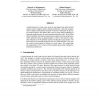10 search results - page 1 / 2 » Optimal Information Decoding from Neuronal Populations with ... |
NIPS
2004
13 years 6 months ago
2004
A typical neuron in visual cortex receives most inputs from other cortical neurons with a roughly similar stimulus preference. Does this arrangement of inputs allow efficient read...
BC
2007
13 years 4 months ago
2007
We consider the issue of how to read out the information from nonstationary spike train ensembles. Based on the theory of censored data in statistics, we propose a ‘censored’ m...
NN
2006
Springer
13 years 4 months ago
2006
Springer
Neurons in area V 2 and V 4 exhibit stimulus specific tuning to single stimuli, and respond at intermediate firing rates when presented with two differentially preferred stimuli (...
IJON
2006
13 years 4 months ago
2006
Sensory systems often use groups of redundant neurons to represent stimulus information both during transduction and population coding of features. This redundancy makes the syste...
NIPS
2007
13 years 6 months ago
2007
Stimulus selectivity of sensory neurons is often characterized by estimating their receptive field properties such as orientation selectivity. Receptive fields are usually deriv...

